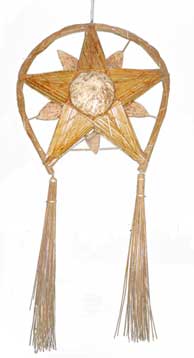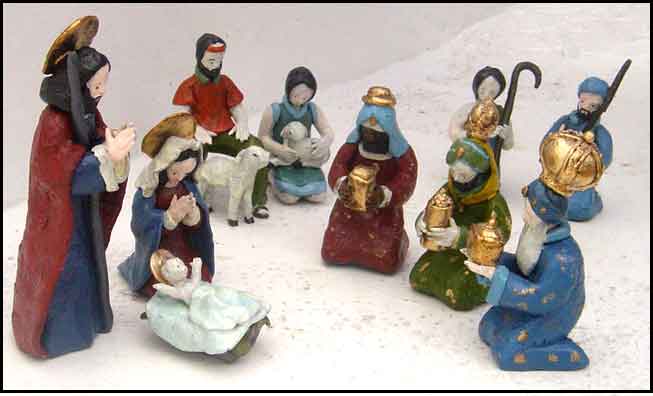 Of
the many Philippine festivals, Christmas takes longest to celebrate
and works most sweetly on the Filipino heart, soul and senses. Of
the many Philippine festivals, Christmas takes longest to celebrate
and works most sweetly on the Filipino heart, soul and senses.
The celebration, rooted in Christianity brought by the Spaniards, is
a mix of religious ceremony, native habits and foreign customs.
The Filipino glorifies the blessed event before and beyond December
25 and, at the same time - with folk ritual and joyous pageantry - celebrates
himself, the Christian whose veneration harks back to the worship of
anitos, the spirits that early Filipinos paid obeisance to.
The story is told that in the 17th century a priest combined Catholic
rites with the native thanksgiving offered to the harvest gods. Farmers
welcomed the new ritual which satisfied their chaplain, the old gods
and their own love of feasting. Daily Masses held before dawn from December
16 to 24 were followed by a hearty breakfast. after which farmers went
to their fields. Truly, a pleasant path to piety. The' practice quickly
spread all over the land. The Misa de Gallo. named after the cock who
crowed with the first peal of church bells, had come to stay.
Like the farmers of old, today's churchgoers are up in the chill dark
before dawn, to hear Mass followed by native breakfast. As dawn lightens
the sky, revelers swarm around the makeshift bamboo stalls standing
near the church, their appetites whetted by fragrant wafts of smoke
from rice cakes baking before their eyes. Fresh from prayers, they joke
and laugh at the bibingka vendor's naughty song about her cake swathed
in banana leaves. "Ang bibingka ko kung lutuin, kaiba sa lahat.
may apoy sa ilalim, may apov sa itaas." Literally. "My cake
cooks like no other, with fire under, with fire over." Merrily
and patiently. the crowd waits three-deep, also for the longer cooking
puto-bumbong. a lavender rice steamed in thin bamboo tubes.
This idyll from the past is still relived in old hometowns and some
city parishes, and is the most cherished of practices preceding December
25. But if nostalgia limns the Misa de Gallo, the other sights and sounds
starting early December are as memorable, even overwhelming.
The landscape changes little with the Christmas season. except for the
riotous bloom of poinsettias. Leaves stay green, earth, brown and gold.
City and country exhibit all the garments and jewels of Christmas heaped
one upon the other, in ordered disarray. yet always delightful, like
a child decked in all her mother's ornaments.
White-painted branches and artificial greens become Christmas trees,
in lieu of fresh pine. the cutting of which is now banned. Shops overflow
with cards, wreaths, candy canes. Santa Claus and snow-spray deck the
otherwise tropical scene.
Christmas lanterns, recalling the Mexican model, are suspended outside
homes, shops and markets. Bamboo sticks and tissue are formed into stars,
hexagons, spheres, cubes. Long ago the tasseled star found its homing
place in the open windows of rural nipa huts. Together they made a portrait
as uniquely native to the Philippines as the Misa de Gallo.
The lanterns' glimmer and the brilliant explosion of a million white
and colored lights gem the nights. Outdoors. the strung bulbs and fluorescents
outline various symbols of Christmas.
Outside Manila, a parade of giant lanterns compete like beauty queens,
each a carnival unto itself, with its own carriage, music, illumination
and escorts.
The religious spirit of Christmas is continually visible in the belen,
the Nativity scene mounted indoors and outdoors. Figures of the Holy
Family, shepherds and kin&s are molded from European originals or
carved by local artisans. (Below: Belen: by Alvin Barcelona, Brgy Lumingon,
Tiaong Quezon: Miniature 2"-5" painted clay figures.)

Heeding that call - which in Easter bids man to look into his soul,
and now at Christmas into his heart - room is made for love of one's
neighbor. Gifts are bought by the dozen, cards sent by the hundred.
Feuds end, quarrels are patched, ceasefires declared.
With midnight of the 24th hours away, carols first aired preciously
in September, now swell to a crescendo of Jingle Bells and Holy Night
alternating with Ang Pasko ay Sumapit (Christmas is Come). Sidewalks
are spilling with tinsel and toys, hawkers and a population in search
of last-minute gifts or respite from less-happy days.
A frenzy of spirit and senses move souls to make ready for the birth
of the Savior and bodies to prepare for next day's crowded feasting.
In the last moments before Christmas Eve, a folksy provincial town reenacts
the Panuluyan (Joseph and Mary's search for a room as her time draws
near). Their pleas are rejected in verse tinged with pathos or humor,
denials ranging from illness to Grandfather's loud snores. The couple
end up in a barn.
The Mass of Christmas Eve, also called Misa de Aguinaldo (Gift Mass),
starts before midnight. hours earlier than Misa de Gallo.
At exactly midnight: church bells ring loud. long and clear. announcing
the birth of the Infant Jesus. Voices rise in song, tambourines rustle,
castanets click. As the Gloria in Excelsis reaches its highest note,
a papier-mache angel descends by invisible string over the manger and
a large star travels by pulley from loft to altar.
Religious fervor and chill midnight air cloak churchgoers hurrying home.
Tonight there is little tarrying at bibingka stalls. for in most homes
waits the Noche Buena. a midnight repast of simple or lavish proportion.
Christmas Eve's festive board features an epicurean display of meats
and seafoods. cakes and sweets and fruits, as if the world's kitchens
had collaborated to mount a feast to end all feasts.
Is there no tomorrow'? sighs a gorged midnight celebrator. Christmas
Day's culinary delights answer with a variety and abundance that sets
appetites reeling. The volume of feasting could easily smother shorter
celebrations or less experienced celebrators. But not the Filipino.
who long ago discovered a method for the melee. Before day is done all
gifts have been distributed, leftover foods given away or stored. Children
have dutifully kissed the hands of ninong and ninang (godparents) and
by nightfall are dreaming of the celebration ahead.
Christmas does not end abruptly. In unwinding pace it stretches to December
28. Feast of the Innocents, to the 31st, when another midnight Mass
and yet another snack ushers in the New Year, and finally to Epiphany,
when the last gifts of the season are placed in children's waiting shoes.
Then Christmas, the Philippines' all too brief longest celebration in
the world, comes to an end.
|
![]()
![]()